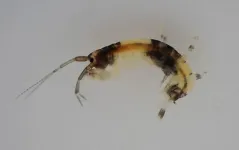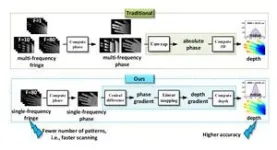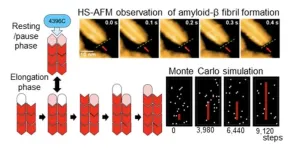(Press-News.org) Decades after it was first found in Japan, a species of crustacean with unique black-and-white coloring that resembles a panda has been confirmed to be new to science. Melitid amphipods are shrimp-like crustaceans found worldwide. The newly classified Melita panda — named after the charismatic mammal — was first found in the 1990s. Details of the discovery and morphological analysis were published in a ZooKeys article on 21 September.
The discovery of the Melita panda highlights the importance of studying species taxonomy, which is the naming and classification of organisms, for conservation efforts. It is impossible to know if a species is in danger of disappearing if it hasn’t even been identified.
“Despite the fact that biodiversity conservation is a global issue, species diversity and other aspects of biodiversity are still not fully understood. As a first step toward species conservation, we conducted a taxonomic study of amphipod Crustacea, which boasts high species diversity around Japan,” said Ko Tomikawa, a professor at Hiroshima University’s Graduate School of Humanities and Social Sciences in Hiroshima, Japan.
Before the discovery of Melita panda, there were 63 known species of Melita amphipods, with 16 of those found in Japan. Melita panda was found in intertidal waters in Wakayama Prefecture, Japan. There are likely even more unidentified and undescribed species of Melita amphipods in Japan’s coastal waters.
“Study on the amphipod Crustacea in the coastal zone of Japan is lagging behind. In order to accurately assess species diversity, taxonomic studies are necessary. We hope the discovery of a new species of amphipod with the familiar coloring of the panda pattern will increase the public’s interest in biodiversity and taxonomy,” said Tomikawa.
To identify the Melita panda, researchers did both a morphological study and molecular phylogeny using genomic DNA. The morphological description of Melita panda found unique features including its panda-like colors and other physical characteristics, while molecular phylogeny is used to identify how closely related the Melita panda is to other Melita amphipods. This information is used to create a phylogenetic tree or evolutionary tree of the known Melita amphipods. Phylogenetic trees are diagrams that show the evolutionary relationships between species.
The molecular phylogeny found that Melita panda is closely related to two other Melita amphipods, the Melita nagatai and Melita koreana. The panda-like coloring distinguishes Melita panda from these two other amphipods, along with other physical differences. Its gnathopods, which are claws that extend from the second thoracic segment, sit more forward than other Melita amphipods, covering another one of its appendages. Its setae, which are hair-like structures that look like bristles, are also distinguishable from other Melita amphipods. Together, the Melita nagatai, Melita koreana, and newly discovered Melita panda form a monophyletic group. This means they have a common evolutionary ancestor. In this case, it is the Melita hoshinoi.
Looking ahead, researchers will continue to study the Melita panda.
“Hopefully, a detailed study of the ecology and behavior of Melita panda will reveal the reason for its panda pattern,” said Tomikawa.
Beyond Melita panda, Tomikawa emphasized that there is still more to study.
“Further taxonomic studies on amphipods in uninvestigated areas are expected to lead to the discovery of additional new species. Continued taxonomic studies are expected to elucidate the biodiversity in the coastal environments of the Japanese archipelago and provide important basic data for species conservation,” he said.
Other contributors include Shigeyuki Yamato of Shirahama Katata in Wakayama, Japan, and Hiroyuki Ariyama at the Osaka Museum of Natural History in Osaka, Japan.
The Japan Society for the Promotion of Science KAKENHI grants supported this research.
###
About Hiroshima University
Since its foundation in 1949, Hiroshima University has striven to become one of the most prominent and comprehensive universities in Japan for the promotion and development of scholarship and education. Consisting of 12 schools for undergraduate level and 4 graduate schools, ranging from natural sciences to humanities and social sciences, the university has grown into one of the most distinguished comprehensive research universities in Japan. English website: https://www.hiroshima-u.ac.jp/en
END
Crustacean with panda-like coloring confirmed to be a new species
2024-10-24
ELSE PRESS RELEASES FROM THIS DATE:
Need for psychology referrals increasing for children with food allergies
2024-10-24
BOSTON (Oct. 24, 2024) – With the rise in incidence of food allergies in children in the past decade, there has been a corresponding increase in the need for professional psychology services due to increased anxiety. A new study being presented at this year’s American College of Allergy, Asthma and Immunology (ACAAI) Annual Scientific Meeting in Boston showed a more than 50% increase in psychology referrals at one center in 2023 compared to yearly referrals from 2018-2022.
“Our center has devoted significant resources to address the psychosocial support needed by many families who have children with food allergies,” ...
Anaphylaxis treatment remains confusing for patients, caregivers and emergency personnel
2024-10-24
BOSTON (Oct. 24, 2024) – Anaphylaxis can come on suddenly and without warning, and because its symptoms can be fatal, it is scary for those who encounter it. Two new studies being presented at this year’s American College of Allergy, Asthma and Immunology (ACAAI) Annual Scientific Meeting in Boston show it is not only patients and caregivers who misunderstand how best to treat anaphylaxis: emergency medical professionals often follow incorrect protocols for treating severe allergic reactions.
“We know early recognition of anaphylaxis and treatment with epinephrine improves outcomes,” says Sasha Alvarado, DO, Co-Director of Quality ...
Penicillin allergy delabeling in syphilis patients assists in furthering treatment
2024-10-24
BOSTON (Oct. 24, 2024) – About 10% of Americans believe they are allergic to penicillin, and approximately 90% of those patients are not actually allergic. As a result, those with the penicillin allergy label are often prescribed more toxic, dangerous and expensive antibiotics that might not be necessary or effective. A new study being presented at this year’s American College of Allergy, Asthma and Immunology (ACAAI) Annual Scientific Meeting in Boston showed that syphilis patients labeled as penicillin allergic who are low risk should be delabeled to avoid treatment failure and other negative ...
Burning incense can pose health risks for those with allergies and asthma
2024-10-24
BOSTON (Oct. 24, 2024) – In many cultures, it is common to burn incense for religious and cultural practices, including meditations, celebrations and spiritual and ancestral worship. A new medically challenging case being presented at this year’s American College of Allergy, Asthma and Immunology (ACAAI) Annual Scientific Meeting in Boston warns that, for those with allergies and asthma, health problems from burning incense can be a significant risk to adults and children.
“Our patient was an 87-year-old woman with history of asthma and COPD, ...
Study: Parents’ understanding of atopic dermatitis may influence child’s diet
2024-10-24
BOSTON (Oct. 24, 2024) – Parents of children with atopic dermatitis (AD, also called eczema) know that the allergic condition can mean a heightened risk of developing food allergies. The desire to prevent food allergies causes some parents to consider elimination diets, cutting out certain foods from their child’s diet. A new study being presented at this year’s American College of Allergy, Asthma and Immunology (ACAAI) Annual Scientific Meeting in Boston showed that elimination diets in the case ...
Vaccine refusal lower in minorities in new study
2024-10-24
BOSTON (Oct. 24, 2024) – Throughout the Covid pandemic, media widely reported that Black patients were more likely than White patients to refuse vaccines, including the influenza and Covid vaccines. A new study being presented at this year’s American College of Allergy, Asthma and Immunology (ACAAI) Annual Scientific Meeting in Boston showed that self-identified non-White patients were less likely to demonstrate vaccine-hesitancy than the self-identified White patient group.
“We found ...
Risk of developing EoE high when other allergic conditions factored in
2024-10-24
BOSTON (Oct. 24, 2024) – Eosinophilic Esophagitis (EoE), a disorder of the esophagus, is increasingly recognized as a major cause of swallowing difficulties in children and adults. It affects about one in 2,000 people and is part of a spectrum of allergic conditions. A new study being presented at this year’s American College of Allergy, Asthma and Immunology (ACAAI) Annual Scientific Meeting in Boston investigated the probability of patients with certain atopic (allergic) conditions developing EoE.
“We did a separate analysis of four common allergic conditions – asthma, allergic rhinitis, atopic dermatitis and food allergy – to determine ...
Study shows rates of sensitization in Chicago to outdoor allergens increased post-COVID
2024-10-24
BOSTON (Oct. 24, 2024) – People have heard for years that climate change is having a significant impact on plant vegetation patterns and influencing how pollen and mold produce. A new study being presented at this year’s American College of Allergy, Asthma and Immunology (ACAAI) Annual Scientific Meeting in Boston showed that, in Chicago, there has been a significant increase in sensitization to pollens and molds in patients with nasal allergies.
“Our goal was to analyze changes in pollen sensitization patterns ...
Phase Two results with CRISPR-Cas9 gene editing support further development as treatment for hereditary angioedema (HAE)
2024-10-24
A single treatment with, a CRISPR-Cas9 based gene editing therapy, is enough to replace the daily medication of patients with hereditary angioedema (HAE), a condition characterized by severe, painful and sudden onset of swelling, sometimes resulting in death. Confirming the findings published earlier this year from researchers from Amsterdam UMC, the University of Auckland and Cambridge University Hospitals NHS Foundation Trust. This phase two study is published today in the New England Journal of Medicine and presented at American College of Allergy, Asthma & Immunology's annual congress on the ...
Take aim at the pause!
2024-10-24
A collaborative research group, including researchers from Exploratory Research Center on Life and Living Systems and Institute for Molecular Science of National Institutes of Natural Sciences, as well as Nagoya City University, Nagoya University, and University of Tsukuba, has uncovered a new mechanism in the growth of amyloid β (Aβ) fibrils, which are closely associated with Alzheimer’s disease. Using advanced high-speed atomic force microscopy (HS-AFM), the team was able to observe Aβ fibril growth at the molecular ...


